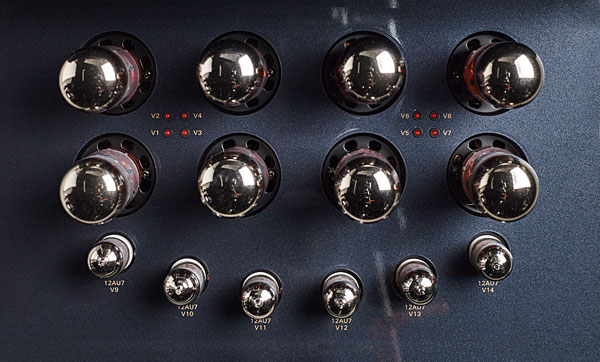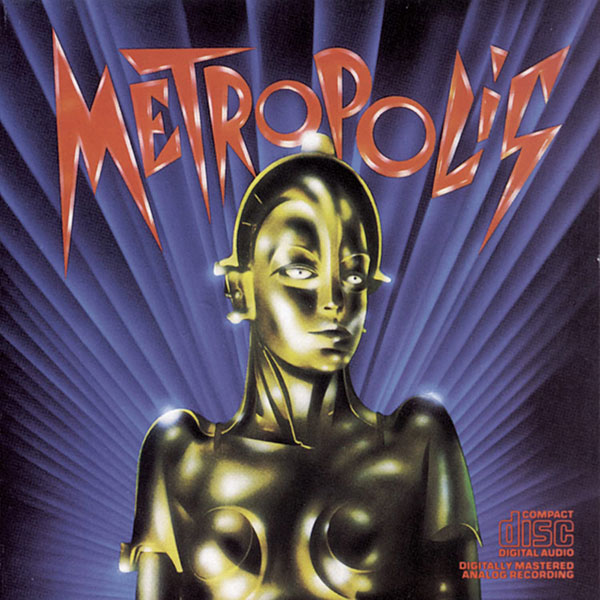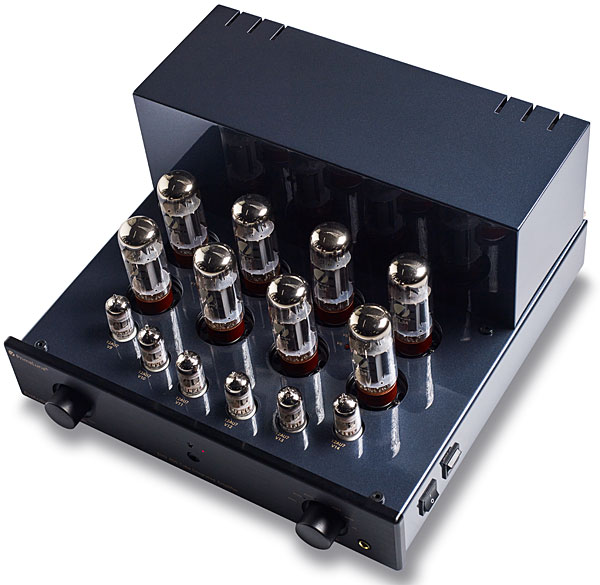| Columns Retired Columns & Blogs |
It flowed for me in much the same way I think the Evo 400 did for you.
Van den Dungen told me that he hates to compromise on quality. These days, he sources tinfoil capacitors from Switzerland, made to his specs, and has them sent to the Netherlands. "Here, we sample for quality, and then they go on transport to China. In China," where PrimaLuna's products are built, "each capacitor is tested, which in fact we do with all our parts: resistors, caps, transistors, FETs, MOSFETs, and tubes of course. If they're not good enough, we send them back to the manufacturer."

List(en)ing surprises
I fed the EVO 400 a signal from my Bluesound Node 2i streamer connected by S/PDIF to the German-made, second-generation RME ADI-2 DAC FS. There was very good synergy between the RME and the PrimaLuna. The smooth but clinically revealing RME, which banishes noise, distortion, and jitter to far beyond the audible range, boasts an admirable, just-the-facts quality that comes from being designed by Teutonic boffins. (It even looks like a piece of lab equipment.) I used it without engaging its bevy of built-in filters or its parametric equalizer. Later, I played music from my 16" MacBook Pro M1 Max running Roon 1.8 into a Roon ROCK via USB, and from there to an Auralic Vega DAC. Speakers were my trusty references: MartinLogan Odyssey electrostats and a pair of Tekton Moabs.
In honor of PrimaLuna's birthplace, I decided to start my 12 weeks of almost-nightly listening with an improvised playlist of Dutch music. First up: Sweet d'Buster's "Bread" (16/44.1 FLAC, Tidal), a fine piece of mid-'70s polderfunk. World-class bassist Herman Deinum lays down a propulsive riff that, through the extraordinary clarity the EVO 400 provides, reveals his instrument unmistakably as a Fender Precision bass.

I soon discovered that this perspicuity is a defining characteristic of the amp, perhaps even more than with the DiaLogue Premium HP, whose treble sometimes sounded a trifle closed in by comparison. When I played the title song from Luwten's 2021 album Draft (24/96 FLAC, Qobuz), the EVO 400 made me aware that delicate and delectable have the same root. For the intro, singer Tessa Douwstra hums a single note and through multitracking adds a second and a third identical one—same pitch, same voice. Through the PrimaLuna, each part was easy to distinguish from its doppelgangers on the neighboring tracks.
On "The Goodbye Look" by Donald Fagen (24/96 FLAC, Tidal), a de facto test track I've played easily more than 500 times, I noticed something that had previously escaped my attention: In the final syllable of the last line of the chorus, on the word look, there's an extra voice in the right channel.
This kind of detail retrieval made for an Easter egg hunt of sorts, an exciting one. What else would the EVO 400 reveal?
Among the surprises: When I listened to Paquito D'Rivera's megafamiliar (to me) "Afro" (16/44.1 FLAC, Tidal), at 3:09, I heard something crinkling or rustling—sheet music, most likely. Another example: On David Bowie's "Bring Me the Disco King" from Reality (16/44.1 FLAC, Qobuz), one vocal note seems off. In the line "stab you from the city spires," on the second syllable of "city," Bowie hits an A where the scale dictates an A-flat. It's not that you can't hear this minor (ha!) flub on other equipment; it's that the PrimaLuna renders it with an elevated, dissective clarity.

Heart vs head
Despite that precise character, the EVO 400 plays to the heart, not the head. I had listening sessions where not a single new remark appeared on the pages of my notepad—not because there wasn't anything to write about but because the PrimaLuna guided me to immersion, not analysis. Case in point: the track "Samhain Labs" from Here Be Dragons (24/44.1 FLAC, Qobuz) by the Kilimanjaro Darkjazz Ensemble. This is ambient noir reminiscent of Angelo Badalamenti, mood music evoking drizzle, fog, glistening streets, upturned collars, and vague menace. Via the PrimaLuna, no particular instrument elbowed to the fore. The amp just took the signal and reproduced it so that the sound came across as organic, holistic, and alive.
When I did manage to take notes, I ended up with phrases like Rife with detail and dimensionality. Inviting, slightly warm, and opulent. Also, solid density of textures; plush.
Headphones, bass, and triodes
One evening, I plugged my Monolith M1060 planar magnetic headphones into the PrimaLuna's headphone jack, mostly to keep from feeling guilty that I'd spent a perfectly good $270 on them even though they're easily bested by several 'phones I own. Listening to Arturo O'Farrill's "The Offense of the Drum" from the album of the same name (24/44.1 FLAC, Qobuz) made me giddy. It was as if the headphones had received a free upgrade to Audeze LCD-2 or LCD-3 status. And when I switched to my Audeze LCD-4s, they too sounded better than before. The weight of the kickdrum, the blattiness of the muy picante trombones—all was represented with panache and color. The PrimaLuna turns things vibrant with a sprinkling of warm pigments but without making a DayGlo, euphonic mess.

"Planners & Thinkers" from Metropolis (Soundtrack) by Metropolis (16/44.1 FLAC, Tidal, footnote 2) revealed a startling amount of tight, room-rattling bass, on a par with the best I've heard from my Moabs. With reggae and dub, I sometimes heard less control in the bass than I do with my solid state gear. Some overhang was present, with the deepest bass notes not as apt to stop on a dime. But the music chugged and jived in ways that left no room for disappointment. Always, 20–30 minutes after I fired it up, the EVO 400 became a glowing little contentment machine, ready to lay bare the soul of any music I threw at it.
In my description of the EVO 400, I failed to mention that you can switch it from Triode mode to Ultralinear on the fly with the included remote control. Which is best? To my ears, Ultralinear provided the clearest lens into the music, prioritizing near-scrupulous fidelity to the source material. But what if that source material needs a little help? Lots of terrific early-'70s pop with a tipped-up upper midrange—the Kinks, say, or Cockney Rebel, or ELO—can sound harsh and ultimately fatiguing. In Triode mode, the PrimaLuna is like a hit of Valium. It takes the edge off.

I had to force myself to refrain from flicking the Triode/Ultralinear switch back and forth on every recording. If the presence of the feature awakens the tweaker and worrier in you, it can become a double-edged sword.
Sounding solid
What of the nontubed competition? A great solid state amp like my Krell FPB 200c, or the Pass Labs INT-60, will render individual performers as if they're standing in white, narrow-beamed aural spotlights, sharply delineated while the space just a foot or two away remains black. It's the kind of sonic treatment I love for its stark precision but that tube lovers may dismiss as clinical.
In contrast, the illumination produced by the PrimaLuna is more gold and amber in character. The spotlights' focus is wider and softer, lighting up the space between the players and letting you take in the whole stage at once. That's fantastic too. Which is better?

The three-horn interplay on the Bud Powell composition "Glass Enclosure" (16/44.1 FLAC, Qobuz), from Sotho Blue by Abdullah Ibrahim and Ekaya, was a standout on the EVO 400, besting the Krell in some ways. The alto sax sounded bright yet burnished, and the baritone displayed that exhilarating ochre-brown hue, that signature dark-colored bzzz that goes straight to the gut. The grand piano was as gorgeously expansive as I've ever heard it, although maybe lacking the cleanest leading-edge definition of each note. The Krell was better at rendering chords as a collection of discernable notes; the PrimaLuna tended toward an impressionistic, holistic picture. To borrow an analogy from the Dutch art world, the Krell painted with the geometrical precision of Johannes Vermeer; the PrimaLuna was more like Vincent van Gogh.
That clinches it: PrimaLuna's EVO 400 is a work of art. If you're on the hunt for a world-class integrated tube amp for less than five figures, it's hard to imagine how you could do better.

It flowed for me in much the same way I think the Evo 400 did for you.

Thanks for that kindness — glad you enjoyed the review!

Or I assume it was more complex than that..?

...I wouldn't say the amp is in any way hamstrung with the stock EL34s. It sounds lovely either way. With the KT150 valves, I get marginally better control of the lower bass, and a more expansive soundstage. It's not night and day though. If you do decide to try the KT150s, I'd wait a while until prices stabilize. The tube market's kinda crazy right now. I have a feeling that tube costs will be lower in the fall, or whenever Russia decides to end its ill-advised invasion and sanctions are lifted.

Enjoyed the mentions of Mesa Baron and Jolida. A Jolida was the first tube amp I heard, back in college. And I still use Mesa, but for my flying V not for hifi.
I don't find tubes to be that tricky, but it's true that some work better for some purposes than others (echoing Kevin Deal's comment). For 12AU7s in my preamp I have NOS Telefunken and a bugle boy, and for unknown reasons, the music sounds more alive with the bugle boy in the gain stage and the tele as cathode follower. I have Psvanes in a smaller setup, but my ears prefer the NOS tubes from reputable sellers (not ebay), especially for line-stage amplification.

Thanks for the thoughtful review Rogier. I'm just getting into the HiFi universe and am, naturally, tube-curious. Question to all: Can anyone speak to the differences in sound of the 400 as compared to the other PM integrated amps down the food chain? 300, 200, etc.? I prioritize sound-stage and transparency and never play loud. Wondering if the same sound signature that Rogier described can be had by stepping down the line. Thank you in advance!

...there's no significant change in sound signature when you go from the 400 to the 300. I've never heard the 200 or 100 so I can't really speak to that. The folks at Upscale Audio should be able to help. My guess is that as long as your speakers are easy to drive, you'll get nearly identical sonics from the "lower" models. Inefficient speakers will do better with increased amplifier power though.
There's also a PrimaLuna owners group on Facebook where everyday users are probably happy to answer your question: https://www.facebook.com/groups/509067122811946

He said the HOLE in the center of the disc, not the disc itself.
PS -- Love this amp. LOVE LOVE LOVE it. My balm during The Lockdown.

Hi
Why not? Anything made in China will cost much less than made-in-original-country. "World-class" or not is another story.
China is a popular OEM for audios nowadays. So tempting for good profit in selling more quantities for lower pricing due to low cost built offshore. Business is business, no charity !
Jack L

[[Edit: In case there are people reading this who don't know it: Kevin Deal (who wrote this comment) is CEO of Upscale Audio and Upscale Distribution; the former sells and the latter distributes PrimaLuna.--Jim Austin]]
PrimaLuna has been called things much greater than "World Class" The late, great Art Dudley said "I've never seen a better-built amp" with no qualification as to price.
We always tell people don't buy a damn thing without looking inside to make sure you are getting what you paid for and not fairy dust.
PrimaLuna is happy to compare side by side with any product at any price.

Did the PrimaLuna have any difficulty driving the Martin Logans to realistic volume levels? After all, they are not the most efficient speakers, especially with the cone drivers below. I am asking because I drive mine with a Krell amp, which is fine, but I am curious to try tubes.

[[Edit: In case there are people reading this who don't know it: Kevin Deal (who wrote this comment) is CEO of Upscale Audio and Upscale Distribution; the former sells and the latter distributes PrimaLuna.--Jim Austin]]
Rogier can comment, but I thought I might mention there is a guy named Pete Soderberg that worked for MartinLogan for something like 15 years, and he works at Upscale Audio now. Give him a call. Also Sean Smollen. He was a MartinLogan product trainer. They both work at Upscale now.

Hi Rogier
I fully agreed to what you heard about PL in triode mode. This sorta 'smoothing' effect has been the typical sonic downside of trioding pentode/tetriode in so many brandname triode-pentode power amps since day one decades back.
This is the historic conventional simple trioding topology employed by most most, if not all, brandname tube amps manufacturers worldwide. It is done by striping the screen grid (G2) to the anode of the pentode/tetrode in the power output stage, directly or indirectly using a serie low-ohm resistor.
Such simple trioding connection puts the screen grid operating the SAME voltage of the plate. This simple & no-cost triode-pentode mode serves a good selling feature for those triode fan lovers, like your truly.
Yet, sonically it makes the orginal punchy forceful sonics of pentode power amp sounds slow, dull like a leaking tire. That's exactly what you called "it takes the edge off" smoothing effect.
That being the case, why install this trioding feature onto the PrimaLuna amp then ? As a sales feature ignoring/without knowing such bad sounding triode effect ?????
Triode power tube always sounds much better than any pentode/tetrode: fast, transparent, silky & melodic. This is due to the signal transfer curves of a triode being linear vs kinked non-linear transfer curves of a pentode/tetrode, e.g. EL-34 etc. This is physics !!!! That's why so many music lovers like true triode music, including me, needless to say.
Despite your pre-review sales pitch for the Dutch designer, it does not change the sonic pitfall the conventional historic trioding pentrode topology he employed. Either he did not do auditioning of his PrimaLuna triode mode prototype enough or he simply took it for granted.
FYI, since I love true triode sound, I spent enough time to experiment the right topology for good triode sound out of a pentode/tetrode, e,g, EL-34 etc. Mainly for economy reason, as triodes, like 300E, 2A3 are very expensive to own , not-that-durable as pentodes & require much more costly complex circuitry.
Instead of the no-cost conventional 'no-brainer' trioding the pentode, the screen grid G2 is connected to the plate of the pentode, e.g. EL-34 etc, BUT with a stabilized potential difference betwen the screen grid & the plate of certain 'optimum' value.
So the trioded pentode is working like a triode BUT with a stablized potential difference between the plate & the screen grid G2.
The sonic improvement is realy rewarding: the pentode now sound like a true triode: silky, elegant & melodic like a true triode, yet retaining the transient, punchy & forceful sonic of a pentode. A sonic combination of both a triode & pentode !!!
My vintage Dynaco ST-70 has been ungraded to switchable triode/ultra-linear mode, using such "plate-G2 split potential' topology for many years now. No sweat! Yet I always set it to triode mode as it sounds soo much better than its factory orginal UL mode.
Listening is believing
Jack L

Testify brother. But it's not for every person or every situation. That's why the Triode / Ultralinear switch is on the remote. I use triode at night because of what you said. The house becomes relaxed.
And by the way, females often prefer triode because they have more sensitive hearing than men do.